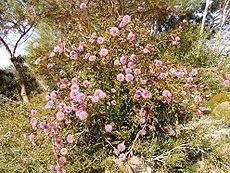Genus Isopogon Rank Species | ||
 | ||
Similar Isopogon latifolius, Isopogon anethifolius, Isopogon formosus, Isopogon anemonifolius, Isopogon | ||
Isopogon cuneatus is a bushy shrub that is endemic to an area around Albany in Western Australia. It occurs naturally in heathland and low woodland.
Contents
Description
Its height usually ranges between 0.5 and 2.5 metres. The pale pink to purplish-pink flowers appear from autumn to spring. Rounded cones containing the seeds appear later, formed from the old flower parts. The leaves are simple and 4–10 cm long.
Taxonomy
It was first described by Robert Brown in 1810. In 1891, German botanist Otto Kuntze published Revisio generum plantarum, his response to what he perceived as a lack of method in existing nomenclatural practice. Because Isopogon was based on Isopogon anemonifolius, and that species had already been placed by Richard Salisbury in the segregate genus Atylus in 1807, Kuntze revived the latter genus on the grounds of priority, and made the new combination Atylus cuneatus for this species. However, Kuntze's revisionary program was not accepted by the majority of botanists. Ultimately, the genus Isopogon was nomenclaturally conserved over Atylus by the International Botanical Congress of 1905.
